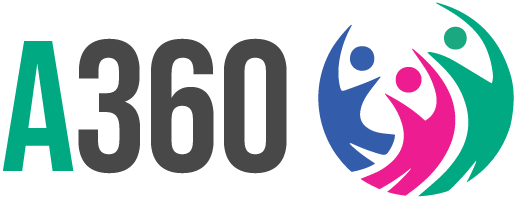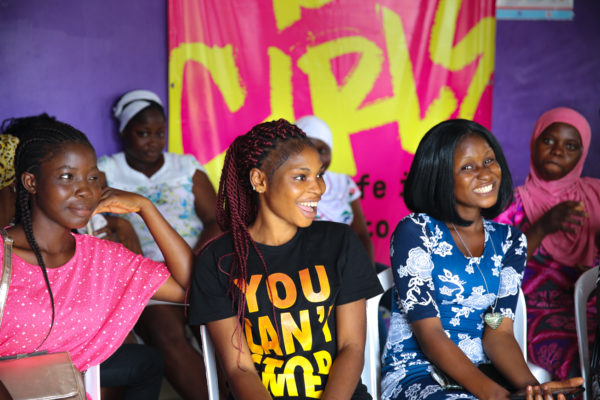A transdisciplinary approach to design and implementation yields a new recipe for reaching young women and girls with sexual and reproductive health services.
By Claire Cole, Implementation Science & Learning Advisor, PSI
There’s something we’ve been simmering on in Adolescents 360 (A360): how to bring together a mix of disciplines and create something delicious and transformative for girls.
Should we be a salad? A stew? And how do we avoid just being simply too many cooks in a kitchen?
I’ve seen a lot of disciplinary salads in my years of working on AYSRH projects. Often in these arrangements, multi-partner projects divide to conquer. In the best case scenarios, each partner imparts their well-established expertise in their given discipline, and the prime attempts to be the salad dressing that ties it all together. Sometimes we eat one ingredient at a time, sequencing application of expertise. And sometimes the prime acts like a well-navigated fork, combining elements for a momentary crunch. When it goes badly we clash and cope and grumble in corridors. And at the end of the day—or project—we go our separate ways, reporting the successes we managed to wrest out, fundamentally unchanged, and wondering if the whole really was greater than the sum of its parts.
“Through a transdisciplinary approach, A360 is blazing a path and bringing others along on our journey to steward transformative, girl-centered implementation.”— Claire Cole, Implementation Science and Learning Advisor, PSI
A360 wanted more than this.
A360 wanted to be a stew. We wanted to get into the kitchen together and blend the disciplines of public health, adolescent developmental science, marketing, Human Centered Design (HCD), cultural anthropology and a heavy dose of meaningful youth engagement, to create transformative approaches to AYSRH service delivery that would work better than solutions driven by any single discipline alone—better than a disciplinary salad. We envisioned a convergence of expertise so thoroughly integrated that it would be unclear where one ended and the next started. We didn’t imagine how challenging it would be—nor how rewarding.
We should have foreseen that we would all leave changed.
In 2017, I joined A360 and, with it, the project’s mandate to increase adolescent girls’ access to and demand for modern contraception in Ethiopia, Nigeria, Tanzania, and beyond. A360 brings a motley crew of state-of-the-art experts to work alongside the girls we’re designing with and for, to develop context-responsive AYSRH solutions.
What has impressed me about A360 most is that, all fanfare aside, we are a legitimate stew. Through this transdisciplinary approach, we are blazing a path and bringing others along on our journey to steward transformative and girl-centered implementation.
And what has this transformative stew meant for our disciplines?
Here are just two examples.
EXAMPLE 1: AYSRH, YOUTH PARTICIPATION, AND HCD—STRONGER, TOGETHER
For some time, our public health field has been discussing the importance of meaningfully engaging youth in order to inform youth-friendly AYSRH programs. A wide range of youth engagement and youth leadership strategies have led to an abundance of documents, programs, and services, labeled as “youth friendly.” And despite these efforts (possibly because sharing power with young people challenges the very moorings of traditional public health programming), we are still, too often, missing the boat.
Meanwhile HCD, a vigorously growing area in development, came from its roots recognizing this critical truth: that the humans you’re designing for should be a central focus of the formative field work that shapes your intervention. Because of that, design teams work with intentional curiosity about the lives and needs of the intended end user– bringing what’s desirable to people into the technical design process very early on. (After all, if we create something that is good for people—but that people don’t want—it will never be effective, much less sustainable).

A360 is delivering a stew (of sorts) that takes meaningful youth engagement to the next level. How? Our Blueprint for Change explores. Click the image to dive in.
But even in HCD, while youth can be both the “subjects” of the research and participants in co-creating interventions, unless young people are brought onto design teams as meaning-makers, ideators, and real decision-makers, the final design of the intervention still rests with adults.
Enter Meaningful Youth Engagement.
You know you’ve done engagement right when the youth you’ve engaged say themselvesthat they felt their contributions were valued, and that they feel ownership over the end product. We often talk about this in A360– done right, youth engagement is magic. Done wrong… it is tokenistic and potentially even harmful.
In A360’s application of Meaningful Youth Engagement, youth are not only sources of insights but are critical partners in gathering and making meaning of information, as participants and decision-makers in design and implementation. The effort to achieve youth engagement isn’t new to AYSRH, but as A360’s partners Ahna Suleiman, of UC Berkeley’s Center on the Developing Adolescent and Jessa Blades, Managing Director for IDEO.org, point out, youth engagement strategies can often be unfocused and unstructured, increasing the risk of that tokenistic outcome, even with best intentions.
Using the HCD process in design provided a very specific structure for A360 to actualize meaningful youth engagement in design. And, in our structured Evidence-based Adaptive Implementation process post-design phase, we’re now carrying that youth participation emphasis forward as the interventions mature.
Blended together, HCD, meaningful youth engagement, and adolescent developmental science have created the type of youth-centered AYSRH programming that, as public health practitioners, we’ve long strived for.

EXAMPLE 2: ADOLESCENT DEVELOPMENTAL SCIENCE—AYSRH GETS A SECRET SAUCE
With our experience in youth programming, PSI brought to A360 a deep technical knowledge and appreciation of the AYSRH evidence-base and how to work within diverse health system contexts.
With the addition of our partner Ahna Suleiman from UC Berkeley’s Center on the Developing Adolescent, A360’s got itself some Secret Sauce.
So much is changing between the ages of 15-19—in the brain, in social context, and in resulting motivations—all affecting girls’ and their partners’ behaviors and decision-making. With Ahna, we’ve mapped out scenarios of young people’s SRH life trajectories –how these changes may happen at different times or paces for youth, depending on their developmental place. Through this, we’ve better tailored our outreach to girls and their partners, and dramatically refined the precision of our timing and strategic targeting.
Ahna’s perspective has allowed us to go beyond just ensuring our interventions are reaching girls, to ensuring that girls get the right type of services at the right time for them—which is both a function of their age, as well as the developmental milestones they’ve experienced. As our A360 Blueprint for Change documents, A360 interventions are built to meet adolescents where they are today, and respond to their rapidly changing bodies, minds, and hearts—backed by developmental science.

COOKING IN THE A360 KITCHEN
If you’ve ever worked on a project in which the technical strategy and theory of change were set from the time the donor said “go,” you will appreciate how fundamentally different a project designed to go where young people take you has to be.
This hasn’t been easy, and has come with its share of discomforts. But for A360, convening a team of unlikely players that included experts and young people as equal stewards of our interventions has allowed us to earnestly respond to youth voices, wherever that led us.
We have made some mistakes along the way, and we’ve got some practical hacks to keep the cooks, well, cooking!
Our experience is ripe with lessons for the global health community to apply and keep building on. By taking team members out of their silos, we, together, are unveiling recipes to transform the fundamentals of AYSRH program design and implementation.
And that’s something to stew on…

SNAPSHOT: ETHIOPIA’S SMART START INTERVENTION IS A POWERFUL EXAMPLE OF THE TRANSDISCIPLINARY APPROACH.
Smart Start sensitively addresses the intergenerational anxiety being experienced by girls, their spouses, and their parents in the face of the country’s changing socioeconomic landscape, introducing new questioning of what it means now to have a “good” life.
- Smart Start’s branding builds on culturally relevant symbols of wealth, prosperity, and stability to communicate the promise implied in couples’ planned financial and reproductive lives (marketing).
- Meeting girls’ holistic needs, today. The intervention is founded with a precise and targeted response to girls’ and couples’ sexual and reproductive health needs, and its service delivery mechanism is integrated into Ethiopia’s Health Extension Program. It is pro-social, recognizes key moment’s in a young girls’ trajectory, and includes experiential exercises to help couples explore and appreciate—both cognitively and emotionally– the costs of early pregnancy in relation to their other shared life goals (adolescent developmental science).
- The transdisciplinary effect: Through the combination of AYSRH, adolescent developmental science, HCD, and anthropology we uncovered a new message with incredible precision to reach both young girls’ and their young male spouses in their exact developmental stage. As testosterone levels continue to rise in younger male spouses, Smart Start’s messages speak to husband’s desire for status and external social approval by focusing on financial life goals that can be achieved with planning. As testosterone levels plateau in girls and older male spouses, messages speak to their desire for a stable future. This amalgam came through the intense input and cross-interrogation of the disciplines, and we are seeing its effects in performance today.
- Impact, to date: We believe it is the synergy that is leading to the staggering efficacy of the intervention: In a single point of contact, 55% of young married girls aged 15-19 who engage with Smart Start takes up a contraceptive method. 26% of these girls choose a long acting, reversible method, a number that outperforms Ethiopia’s national average of 18% LARC uptake among girls aged 15-19.
Adolescents 360 (A360) is a four-and-a-half year initiative co-funded by the Bill & Melinda Gates Foundation and the Children’s Investment Fund Foundation (CIFF). The project is led by Population Services International (PSI) together with IDEO.org, University of California at Berkeley Center on the Developing Adolescent, the Society for Family Health Nigeria, and Triggerise. The project is being delivered in Ethiopia, Nigeria and Tanzania, in partnership with local governments, local organizations, and local technology and marketing firms. In Tanzania, A360 is building on an investment and talent from philanthropist and design thinker Pam Scott.






